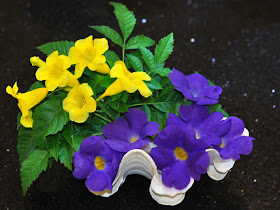The so called single-petaled Hibiscus has a single tier of five petals. This red variety is the national flower of
Malaysia. It is robust, carries many blooms and rather disease-free so
much so that at one time, it was commonly used as living hedges.
Recently there seems to be a revival of this practice.
The hibiscus flower appears to be quite cheeky with its "tongue" sticking out. 
Small and pointy buds.

The petals are seen peeking out, waiting to burst at the seams of the calyx.

The next day it emerged and protruded forwards.
At this stage the bud looks like a stoma; Hello!
When the hibiscus is in full bloom, the petals flare out and curve slightly backwards. The edge of the petals are frilly.
This variety has green-white variegated leaves, so is named 'Snowflakes'.

An ant trekked up one of the five branches of the style and

scrambled onto the tuft-covered stigma.
"It is easier to go down a hill than up,
but the view is from the top"- Arnold Bennett

And the descent down.
The numerous anthers seem to be swollen with their contents. The stigmata are covered with fine filaments.

Later in the day the anthers burst to release fine pollens.
What is left after the petals dropped off the next day.
Given sufficient fertilizer, they bloom non-stop.

Hibiscus hedge just outside the arrival level at Kuala Lumpur international Airport (KLIA ).

This bush was transported from another garden in my hometown, then re-potted here in this urban setting where it seems to be thriving. In order to transplant this Hibiscus plant, I had all the flowers and most of the leaves pruned off.

It was such a waste to dump it so they ended up in a vase.
A simple arrangement where leaves and flower are plonked into a glass globe of water.
A dish of Black Pepper Chicken with Bell Peppers.
Given sufficient fertilizer, they bloom non-stop.

Hibiscus hedge just outside the arrival level at Kuala Lumpur international Airport (KLIA ).

This bush was transported from another garden in my hometown, then re-potted here in this urban setting where it seems to be thriving. In order to transplant this Hibiscus plant, I had all the flowers and most of the leaves pruned off.

It was such a waste to dump it so they ended up in a vase.
A simple arrangement where leaves and flower are plonked into a glass globe of water.
A dish of Black Pepper Chicken with Bell Peppers.


















































